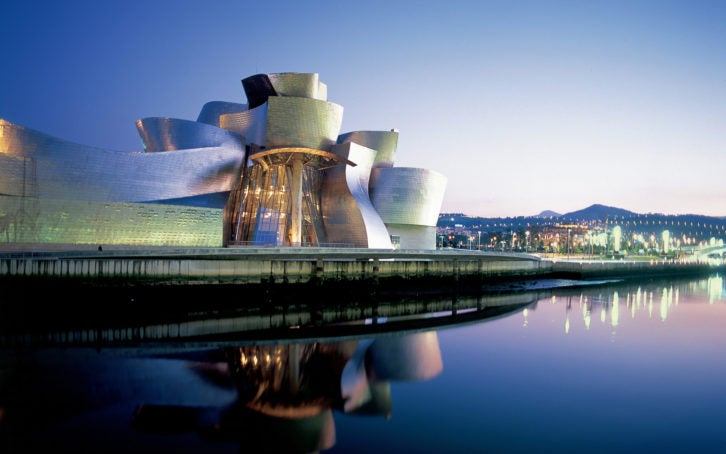In this latest article in our ongoing Spain series, Elite Traveler takes a look at some of the country’s most impressive architecture. From ancient cathedrals to contemporary museums, Spain boasts some of the most treasured buildings in the world. Here, we take a look at five examples that are worth the journey alone.
The Guggenheim Museum Bilbao

The Guggenheim Museum in Bilbao / ©Edwin Poon – Flickr
Frank Gehry’s outlandish example of Deconstructivism was hailed as a spectacular feat of design and engineering when it was inaugurated in 1997. Two decades later, no structure has managed to capture the imagination in the same way. It now stands as a symbol of Bilbao’s remarkable rise from a post-industrial town to an international tourism hotspot. Indeed, the museum was built on an industrial wasteland on the banks of the Ría del Nervión, an area that has since been transformed into a cultural hub.
Gehry took inspiration from Bilbao’s nautical history. The city was once a hub of Spanish ship-building and a major fishing port. The building is designed to resemble a ship and the titanium tiles shimmer in the sunshine like fish scales. The Guggenheim is now one of Spain’s most visited – and treasured – sites and boasts a fine collection of modern and contemporary art. However, the most famous piece of artwork on site is that of the building itself.
La Sagrada Familia Barcelona
Started in 1882 and still yet to be completed, La Sagrada Familia is longest ongoing construction project in modern history. Efforts have been ramped up to complete it in 2026, which would mark a century after its architect Antoni Gaudí, but this 140-year project has been delayed time and time again. Still, what stands there today is one of the world’s most awe-inspiring buildings and certainly the best example of Gaudí’s unique style of modernism.
Although construction continues on a daily basis, it attracts over 4.5 million visitors every year. Although many parts of the site are closed off, there is still plenty to marvel at. The extraordinary roof is held up by angled pillars that soar towards the ceiling, giving it the effect of a gigantic forest canopy. The shape and the placement of each window was specifically developed to emphasize the forest effect as they create the effect of sunlight shining through the branches of a tree.
The continued work on the site causes controversy within Barcelona, with some arguing it has mutated far beyond Gaudí’s initial vision. The project was still in its early days when Gaudí was hit by a tram and killed and may of his models were destroyed by anarchists in 1936. The current version has been developed from a computer model based on what very little remained of Gaudí’s sketches, which many believe to be far removed from Gaudí’s intention.
Catedral de Sevilla Seville

Catedral de Sevilla / ©Matt Kieffer – Flickr
Seville is a relatively small and enclosed city, which makes the immense cathedral seem even bigger than it is. The largest Gothic cathedral in the world, Catedral de Sevilla was constructed between 1434 and 1517, but records indicate that the site has continuously been used as a holy ground since the 12th century.
A grand mosque is believed to have been built on the same site by Seville’s Almohad rulers. The city was captured by Fernando III in 1248 and it took another 153 years before the Christian leaders decided to demolish the mosque and replace it with an even grander replacement. Part of the original structure remains, however, most notably the minaret which is incorporated into the cathedral’s incredible bell tower, Giralda.
Visitors can marvel at a fine collection of art and historic treasures in the Sala del Pabellón and Americans will be particularly interested in visiting the tomb of Christopher Columbus. There is, however, some doubt that the monument actually contains the explorer’s remains.
Alhambra Palace Granada

Alhambra Palace in Granada / ©Jiuguang Wang – Flickr
Set among the stunning peaks of the Sierra Nevada, Grenada is one of Spain’s diamonds in the rough. Many visitors come just to stand in awe of the Alhambra, a stunning citadel that boasts incredible Islamic architecture and gorgeous gardens.
Many of the buildings that stand today date back to the 13th and 14 centuries, but some archaeologists believe the site was first built upon in Roman times. Its original mosque was replaced by a church following the 1492 Reconquista but many original structures still stand, making it historically significant for Islamic Europe.
Many of the site’s 6,000 daily visitors immediately flock to Palacios Nazaríes, a stunning palace complex and a worthy centerpiece to the entire site. They also wander around the magical Generalife, the sultans’ summer estate where paths lead you to myriad fountains and flower displays.
La Mezquita Cordoba

La Mezquita in Cordoba / ©Katie Bordner – Flickr
We finish with another stunning example of Spain’s Islamic past. La Mezquita is widely considered to be one of the finest pieces of Islamic architecture. The mosque was bult after Abd ar-Rahman I purchased a grand church in 784 with the aim of erecting a grand mosque. The site has been extended several times over the preceding 1,300 years but remained largely unchanged throughout the Christian conquest.
The only major change came in the 16th century when King Carlos I granted permission to rip out the center of the Mezquita in order to construct a cathedral. It took almost 250 years to complete and is now commonly known as the ‘Mezquita-Catedral’ Visitors can climb to the top of the 54m-high bell tower for a fantastic view across Cordoba. From here, the massive scale of the main Mezquita building becomes apparent. Only 20 people are allowed up the tower every half an hour and tickets sell out well ahead of visiting time.










